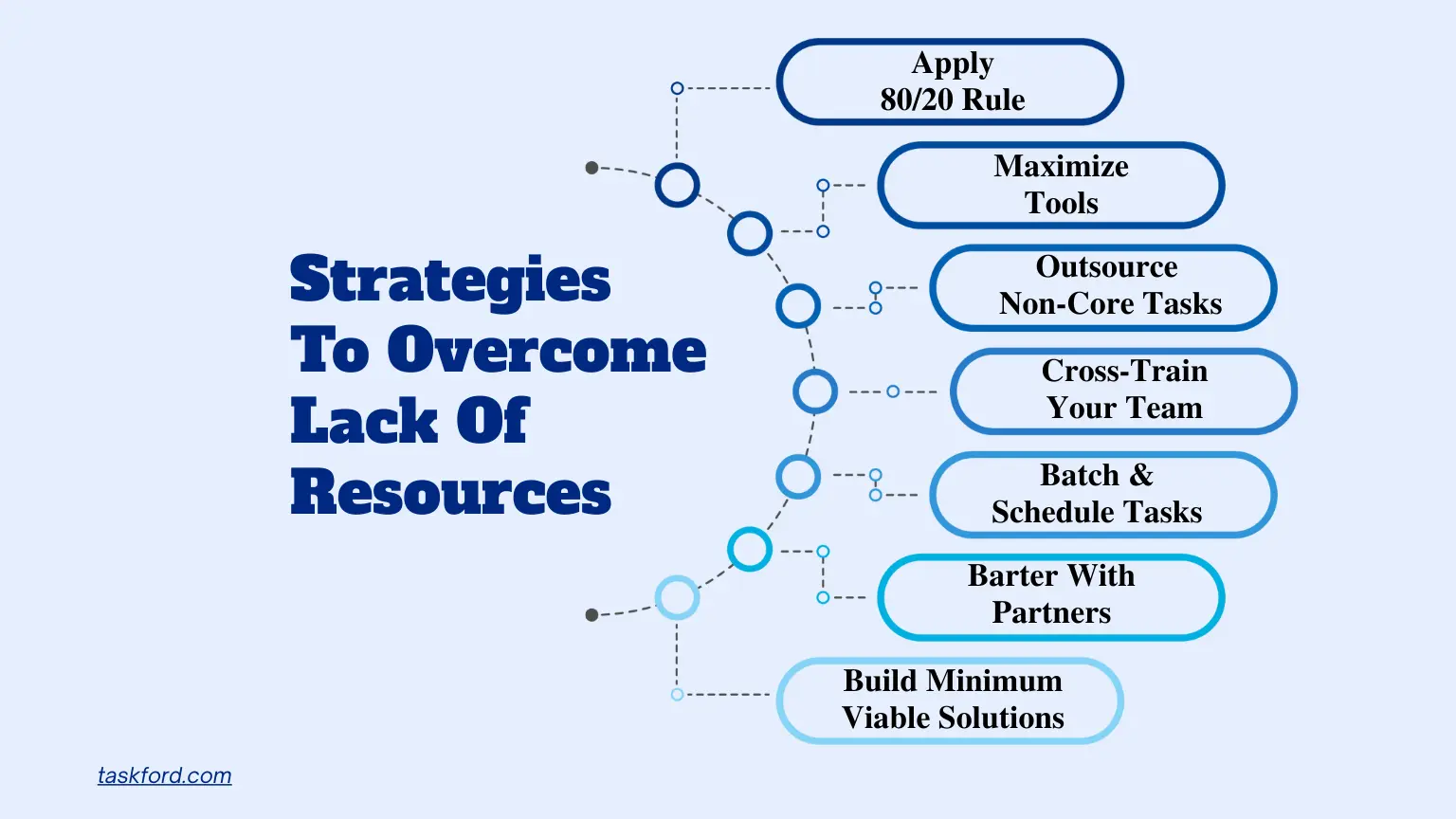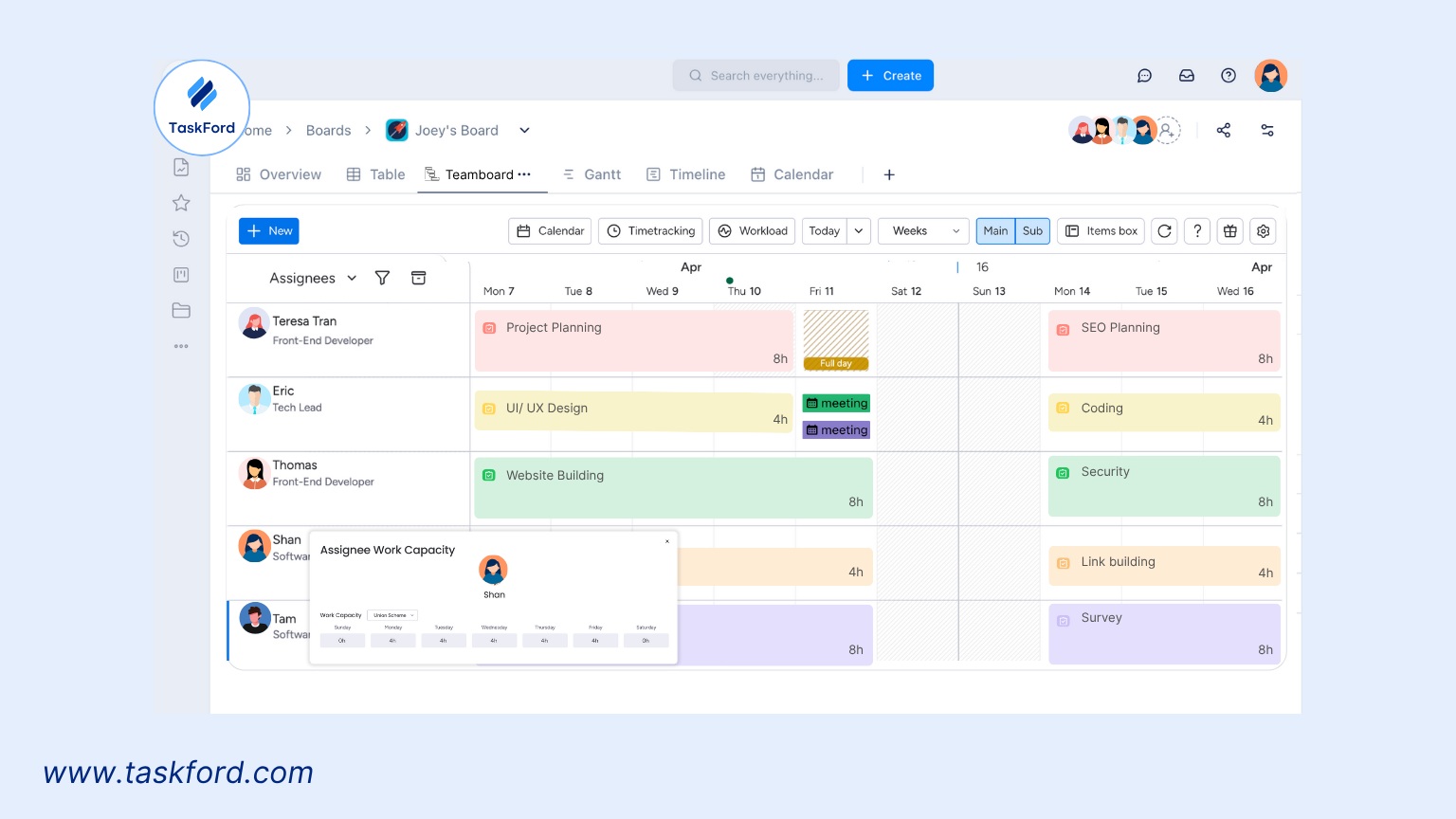Lack of Resources? 7 Smart Ways to Deliver Results Anyway
Discover seven practical strategies to achieve outstanding results despite limited resources, with insights on resource management and how TaskFord can help.
Resource scarcity is a challenge every business, startup, or project team faces at some point. Tight budgets, small teams, or outdated tools can feel like major barriers. Yet, constraints often spark creativity, pushing teams to work smarter and uncover innovative solutions. With sharp resource management and practical strategies, you can achieve impressive results even when resources are limited.
This blog explores seven actionable ways to overcome a lack of resources, with insights on resource planning, common pitfalls to avoid, and how TaskFord can support your efforts to maximize efficiency and drive project success.
What Is Resource Planning?
Resource planning is the process of identifying, allocating, and managing resources like time, budget, people, and tools to meet project or business goals efficiently. It involves forecasting needs, assessing what is available, and scheduling tasks to maximize efficiency. Effective resource planning prevents overuse or underuse of resources, which is crucial when working with less. A clear plan helps prioritize high-impact tasks and avoid bottlenecks.
For more details, check out our detailed explanation about Resource Planning
The Reality of Resource Scarcity
A lack of resources is not just about low funds or a lean team. It can mean tight deadlines, outdated technology, missing skills, or limited data for decisions. These hurdles can lead to stress, missed deadlines, or reduced quality. But scarcity does not have to stop you. By rethinking resource allocation, embracing creative problem-solving, and focusing on team productivity, you can turn limitations into opportunities for innovation.
Common Pitfalls When Managing Limited Resources
When resources are scarce, small mistakes can have big consequences. Avoiding common pitfalls helps you optimize what you have. Here are four frequent missteps and how to navigate them:
- Overcommitting Resources: Taking on too many projects stretches teams and budgets thin, leading to burnout or failure. Assess capacity realistically and prioritize high-value projects to stay focused.
- Ignoring Team Burnout: Pushing a small team too hard lowers morale and productivity. Monitor workloads, encourage breaks, and balance task assignments to maintain energy.
- Neglecting Data-Driven Decisions: Guessing where to allocate resources wastes effort. Use analytics, even simple spreadsheets, to track performance and prioritize high-impact tasks.
- Poor Communication: Miscommunication leads to wasted time and duplicated efforts. Set clear goals, deadlines, and roles, and use centralized tools for team alignment.
By sidestepping these pitfalls, you create a foundation for effective resource management and better outcomes, even with limited resources.
7 Smart Strategies to Overcome a Lack of Resources

The following seven strategies, combined with effective resource management, will help you deliver results, no matter the constraints.
1. Apply the 80/20 Rule for Maximum Impact
The 80/20 rule, or Pareto Principle, states that 80% of your results come from 20% of your efforts. Focus resources on high-value tasks or projects that drive the most impact.
- Identify key drivers: Analyze which tasks, like email campaigns for a marketing team, yield the highest ROI.
- Use data to guide decisions: Tools like Google Analytics can track performance to pinpoint high-impact areas.
- Cut low-value efforts: Reduce time and funds spent on less effective activities to free up resources.
This focused approach ensures your limited resources deliver significant results.
Quick Tip: Review past projects to pinpoint your high-impact 20% and reallocate resources accordingly.
2. Maximize Existing Tools and Technology
You do not need new software to succeed. Many teams underuse their current tools, like project management platforms or CRMs, missing out on valuable features.
- Audit your tools: Check for unused functions like task templates or reporting tools.
- Leverage free options: Use Google Workspace or Trello to fill gaps without extra costs.
- Boost efficiency: Simple spreadsheets can track tasks if dedicated software is unavailable.
Maximizing what is available reduces costs and enhances project efficiency.
Quick Tip: Hold a team session to explore your tools’ full capabilities and share best practices.
3. Outsource Non-Core Tasks Strategically
When your team lacks specific skills, outsourcing is a cost-effective way to access expertise without hiring full-time staff.
- Hire freelancers for niche tasks: For example, contract a graphic designer for a one-off project.
- Use platforms like Upwork or Fiverr: These connect you with talent for short-term needs.
- Keep critical tasks in-house: Outsource non-core work like content writing to maintain focus.
Clear briefs and check-ins ensure quality and alignment with your goals.
Quick Tip: Write detailed project briefs for freelancers to ensure they deliver what you need.
4. Cross-Train Your Team for Flexibility
A small team can feel limiting, but cross-training creates a versatile workforce, reducing dependency on single roles.
- Teach multiple skills: A project manager learning basic content creation can handle diverse tasks.
- Use shadowing sessions: Pair team members to share knowledge efficiently.
- Foster collaboration: Internal workshops build adaptability and team cohesion.
This approach boosts resilience against workload spikes or absences with minimal investment.
Quick Tip: Start with simple cross-training, like teaching basic social media or data entry skills.
5. Batch and Schedule Tasks to Save Time
Time is a critical resource, and mismanaging it worsens scarcity. Task batching and scheduling cut inefficiency.
- Group similar tasks: Set 30-minute blocks for emails to reduce distractions.
- Use scheduling tools: Even a calendar app can align tasks with team availability and deadlines.
- Prioritize high-impact work: Free up time for critical tasks by minimizing context-switching.
Strategic time management improves team productivity and maximizes output.
Quick Tip: Block out one-hour batching sessions for repetitive tasks like email or reporting.
6. Barter with Partners for Mutual Benefit
When budgets are tight, bartering with other businesses or freelancers can unlock resources without cash.
- Trade services: A web development agency could swap website work for marketing services.
- Reach out to your network: Find win-win partnerships with clear value exchanges.
- Maintain clear agreements: Open communication prevents misunderstandings.
Bartering saves money and builds relationships for future collaborations.
Quick Tip: List your team’s strengths to identify what you can offer in a barter arrangement.
7. Build Minimum Viable Solutions
Perfectionism can derail progress when resources are low. Focus on minimum viable solutions (MVS) to meet core needs.
- Start small: Launch a basic product version to test ideas and gather feedback.
- Refine based on input: Use user insights to improve, focusing resources on what matters.
- Track progress simply: Basic task management tools can keep iterations on track.
This lean approach reduces costs and ensures resources go toward valued features.
Quick Tip: Define the core features your project needs and focus resources there.
TaskFord: Your Partner in Overcoming Resource Scarcity

TaskFord's resource management platform is designed to help teams achieve more with less, making it ideal for tackling resource constraints. The platform offers tools to enhance resource planning and boost team productivity:
- Resource Allocation: Assign tasks based on skills and availability for efficiency.
- Time Tracking: Monitor time to optimize output and spot inefficiencies.
- Collaboration Features: Centralize communication and file-sharing to keep teams aligned.
- Analytics: Gain insights into progress and resource use for smarter decisions.
TaskFord ensures every hour, dollar, and team member counts. Join our waitlist today to transform your approach to resource management.
Turning Constraints into Opportunities
A lack of resources is not a dead end, it is a chance to innovate. By prioritizing high-impact tasks, maximizing tools, outsourcing smartly, cross-training, optimizing time, bartering, and delivering minimum viable solutions, you can achieve results despite limitations. Avoiding common pitfalls and leveraging resource management unlocks your potential. Ready to turn constraints into opportunities? Explore TaskFord’s features and optimize your resources today.
Learn more
- Crafting a Resource Management Plan: A Project Manager's Handbook
- Understanding Resource Allocation: Key Concepts for Project Managers
- What Is Resource Breakdown Structure (RBS)? The Ultimate Guide for Project Managers
Making work simpler,
smarter, and more connected
Join our waitlist and be notified first.

Related Blog
Subscribe for Expert Tips
Unlock expert insights and stay ahead with TaskFord. Sign up now to receive valuable tips, strategies, and updates directly in your inbox.






